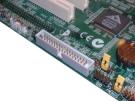 CD-RW, will allow you to read and write to CDs; DVD-ROM will allow you to read both CDs and DVDs; DVD-RW will allow you to read and write both CDs and DVDs. If you are unsure what type of device, or devices, you have on your PC you can check by going into the Device Manager, expanding the entry for DVD/CD ROM drives and looking at the properties for each entry.
CD-RW, will allow you to read and write to CDs; DVD-ROM will allow you to read both CDs and DVDs; DVD-RW will allow you to read and write both CDs and DVDs. If you are unsure what type of device, or devices, you have on your PC you can check by going into the Device Manager, expanding the entry for DVD/CD ROM drives and looking at the properties for each entry.The CD and DVD units that fit into your PC are a standardised size to fit in the 5.25" bays found at the top of the system case.
 The picture shows how it looks before mounting in the system case. There are three connections on the back end of the unit: a ribbon cable that connects to the motherboard, identical to the one that connects the hard disc drive; a 12V Molex power connector that comes from the power supply unit which powers the motor that spins the discs; an audio lead that connects to the sound card or sound module on the motherboard (without this you will hear system sounds and sounds in games, but not music from CDs).
The picture shows how it looks before mounting in the system case. There are three connections on the back end of the unit: a ribbon cable that connects to the motherboard, identical to the one that connects the hard disc drive; a 12V Molex power connector that comes from the power supply unit which powers the motor that spins the discs; an audio lead that connects to the sound card or sound module on the motherboard (without this you will hear system sounds and sounds in games, but not music from CDs).Just a couple of points in relation to CD and DVD units.
1. If you want to record music CDs that you will play on other CD players, such as in a car or home CD player, don't use CD-RW (rewritable) discs. While these will normally replay fine on the CD drive that they were recorded on, they don't always play on other units. Stick to CD-R (recordable) discs.
2. To be able to play DVDs on your PC you need to have a video codec (compressor/decompressor) installed, which is a piece of software produced by companies like nVidia or Intervideo. Chances are that such a codec was installed on your PC when you purchased it. However, if you ever have to reinstall your operating system don't be surprised if you can't play DVDs. Windows XP does not natively support DVD playback and you will have to install a third party codec - either one that came on the discs supplied by your PC manufacturer, or you will have to purchase a third party codec.
3. Don't be cheap when buying CD and DVD recordable media. From my own experience I can tell you that if you buy no-brand, "50 for €10.99" discs you should be prepared to end up with a lot of coasters. Cheap media often do not play back well on any unit but the one that they were recorded on - stick with a good brand like Verbatim, Imation or Traxdata.
While it isn't an optical drive, I want to say a few brief words about floppy disc drives in this

 section as they don't warrant a section to themselves. The floppy disc drive, if you have one, and you probably do, is attached to the FDD connector on the motherboard by a ribbon cable and it has its own power connector that comes from the power supply unit (see the pictures).
section as they don't warrant a section to themselves. The floppy disc drive, if you have one, and you probably do, is attached to the FDD connector on the motherboard by a ribbon cable and it has its own power connector that comes from the power supply unit (see the pictures).In the 21st Century, nobody should still be depending on floppy discs for backing up their data. Modern day floppy discs are notoriously unreliable as they are being manufactured too cheaply to assure quality. PC Medic has found that up to 30% of discs bought at retail level cannot be written to and many of those that can be written to cannot be read at a later date. Do not put your trust in floppy discs - use more reliable methods such as CD or USB memory sticks. You have been warned.
Next ... the PSU.
No comments:
Post a Comment